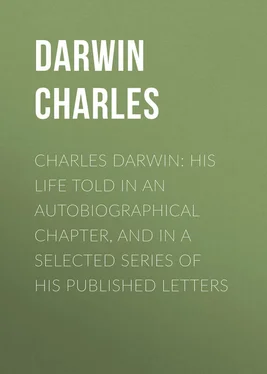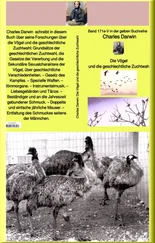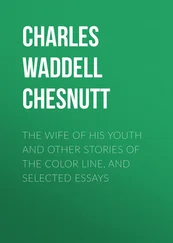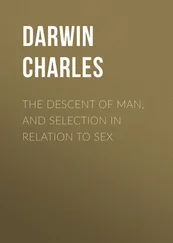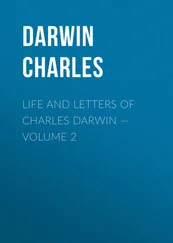Charles Darwin - Charles Darwin - His Life Told in an Autobiographical Chapter, and in a Selected Series of His Published Letters
Здесь есть возможность читать онлайн «Charles Darwin - Charles Darwin - His Life Told in an Autobiographical Chapter, and in a Selected Series of His Published Letters» — ознакомительный отрывок электронной книги совершенно бесплатно, а после прочтения отрывка купить полную версию. В некоторых случаях можно слушать аудио, скачать через торрент в формате fb2 и присутствует краткое содержание. Жанр: foreign_antique, foreign_prose, на английском языке. Описание произведения, (предисловие) а так же отзывы посетителей доступны на портале библиотеки ЛибКат.
- Название:Charles Darwin: His Life Told in an Autobiographical Chapter, and in a Selected Series of His Published Letters
- Автор:
- Жанр:
- Год:неизвестен
- ISBN:нет данных
- Рейтинг книги:5 / 5. Голосов: 1
-
Избранное:Добавить в избранное
- Отзывы:
-
Ваша оценка:
- 100
- 1
- 2
- 3
- 4
- 5
Charles Darwin: His Life Told in an Autobiographical Chapter, and in a Selected Series of His Published Letters: краткое содержание, описание и аннотация
Предлагаем к чтению аннотацию, описание, краткое содержание или предисловие (зависит от того, что написал сам автор книги «Charles Darwin: His Life Told in an Autobiographical Chapter, and in a Selected Series of His Published Letters»). Если вы не нашли необходимую информацию о книге — напишите в комментариях, мы постараемся отыскать её.
Charles Darwin: His Life Told in an Autobiographical Chapter, and in a Selected Series of His Published Letters — читать онлайн ознакомительный отрывок
Ниже представлен текст книги, разбитый по страницам. Система сохранения места последней прочитанной страницы, позволяет с удобством читать онлайн бесплатно книгу «Charles Darwin: His Life Told in an Autobiographical Chapter, and in a Selected Series of His Published Letters», без необходимости каждый раз заново искать на чём Вы остановились. Поставьте закладку, и сможете в любой момент перейти на страницу, на которой закончили чтение.
Интервал:
Закладка:
It has sometimes been said that the success of the Origin proved "that the subject was in the air," or "that men's minds were prepared for it." I do not think that this is strictly true, for I occasionally sounded not a few naturalists, and never happened to come across a single one who seemed to doubt about the permanence of species. Even Lyell and Hooker, though they would listen with interest to me, never seemed to agree. I tried once or twice to explain to able men what I meant by Natural selection, but signally failed. What I believe was strictly true is that innumerable well-observed facts were stored in the minds of naturalists ready to take their proper places as soon as any theory which would receive them was sufficiently explained. Another element in the success of the book was its moderate size; and this I owe to the appearance of Mr. Wallace's essay; had I published on the scale in which I began to write in 1856, the book would have been four or five times as large as the Origin , and very few would have had the patience to read it.
I gained much by my delay in publishing from about 1839, when the theory was clearly conceived, to 1859; and I lost nothing by it, for I cared very little whether men attributed most originality to me or Wallace; and his essay no doubt aided in the reception of the theory. I was forestalled in only one important point, which my vanity has always made me regret, namely, the explanation by means of the Glacial period of the presence of the same species of plants and of some few animals on distant mountain summits and in the arctic regions. This view pleased me so much that I wrote it out in extenso , and I believe that it was read by Hooker some years before E. Forbes published his celebrated memoir 41 41 Geolog. Survey Mem. , 1846.
on the subject. In the very few points in which we differed, I still think that I was in the right. I have never, of course, alluded in print to my having independently worked out this view.
Hardly any point gave me so much satisfaction when I was at work on the Origin , as the explanation of the wide difference in many classes between the embryo and the adult animal, and of the close resemblance of the embryos within the same class. No notice of this point was taken, as far as I remember, in the early reviews of the Origin , and I recollect expressing my surprise on this head in a letter to Asa Gray. Within late years several reviewers have given the whole credit to Fritz Müller and Häckel, who undoubtedly have worked it out much more fully, and in some respects more correctly than I did. I had materials for a whole chapter on the subject, and I ought to have made the discussion longer; for it is clear that I failed to impress my readers; and he who succeeds in doing so deserves, in my opinion, all the credit.
This leads me to remark that I have almost always been treated honestly by my reviewers, passing over those without scientific knowledge as not worthy of notice. My views have often been grossly misrepresented, bitterly opposed and ridiculed, but this has been generally done, as I believe, in good faith. On the whole I do not doubt that my works have been over and over again greatly overpraised. I rejoice that I have avoided controversies, and this I owe to Lyell, who many years ago, in reference to my geological works, strongly advised me never to get entangled in a controversy, as it rarely did any good and caused a miserable loss of time and temper.
Whenever I have found out that I have blundered, or that my work has been imperfect, and when I have been contemptuously criticised, and even when I have been overpraised, so that I have felt mortified, it has been my greatest comfort to say hundreds of times to myself that "I have worked as hard and as well as I could, and no man can do more than this." I remember when in Good Success Bay, in Tierra del Fuego, thinking (and, I believe, that I wrote home to the effect) that I could not employ my life better than in adding a little to Natural Science. This I have done to the best of my abilities, and critics may say what they like, but they cannot destroy this conviction.
During the two last months of 1859 I was fully occupied in preparing a second edition of the Origin , and by an enormous correspondence. On January 1st, 1860, I began arranging my notes for my work on the Variation of Animals and Plants under Domestication ; but it was not published until the beginning of 1868; the delay having been caused partly by frequent illnesses, one of which lasted seven months, and partly by being tempted to publish on other subjects which at the time interested me more.
On May 15th, 1862, my little book on the Fertilisation of Orchids , which cost me ten months' work, was published: most of the facts had been slowly accumulated during several previous years. During the summer of 1839, and, I believe, during the previous summer, I was led to attend to the cross-fertilisation of flowers by the aid of insects, from having come to the conclusion in my speculations on the origin of species, that crossing played an important part in keeping specific forms constant. I attended to the subject more or less during every subsequent summer; and my interest in it was greatly enhanced by having procured and read in November 1841, through the advice of Robert Brown, a copy of C. K. Sprengel's wonderful book, Das entdeckte Geheimniss der Natur . For some years before 1862 I had specially attended to the fertilisation of our British orchids; and it seemed to me the best plan to prepare as complete a treatise on this group of plants as well as I could, rather than to utilise the great mass of matter which I had slowly collected with respect to other plants.
My resolve proved a wise one; for since the appearance of my book, a surprising number of papers and separate works on the fertilisation of all kinds of flowers have appeared; and these are far better done than I could possibly have effected. The merits of poor old Sprengel, so long overlooked, are now fully recognised many years after his death.
During the same year I published in the Journal of the Linnean Society , a paper On the Two Forms, or Dimorphic Condition of Primula , and during the next five years, five other papers on dimorphic and trimorphic plants. I do not think anything in my scientific life has given me so much satisfaction as making out the meaning of the structure of these plants. I had noticed in 1838 or 1839 the dimorphism of Linum flavum , and had at first thought that it was merely a case of unmeaning variability. But on examining the common species of Primula, I found that the two forms were much too regular and constant to be thus viewed. I therefore became almost convinced that the common cowslip and primrose were on the high-road to become diœcious; – that the short pistil in the one form, and the short stamens in the other form were tending towards abortion. The plants were therefore subjected under this point of view to trial; but as soon as the flowers with short pistils fertilised with pollen from the short stamens, were found to yield more seeds than any other of the four possible unions, the abortion-theory was knocked on the head. After some additional experiment, it became evident that the two forms, though both were perfect hermaphrodites, bore almost the same relation to one another as do the two sexes of an ordinary animal. With Lythrum we have the still more wonderful case of three forms standing in a similar relation to one another. I afterwards found that the offspring from the union of two plants belonging to the same forms presented a close and curious analogy with hybrids from the union of two distinct species.
In the autumn of 1864 I finished a long paper on Climbing Plants , and sent it to the Linnean Society. The writing of this paper cost me four months: but I was so unwell when I received the proof-sheets that I was forced to leave them very badly and often obscurely expressed. The paper was little noticed, but when in 1875 it was corrected and published as a separate book it sold well. I was led to take up this subject by reading a short paper by Asa Gray, published in 1858. He sent me seeds, and on raising some plants I was so much fascinated and perplexed by the revolving movements of the tendrils and stems, which movements are really very simple, though appearing at first sight very complex, that I procured various other kinds of climbing plants, and studied the whole subject. I was all the more attracted to it, from not being at all satisfied with the explanation which Henslow gave us in his lectures, about twining plants, namely, that they had a natural tendency to grow up in a spire. This explanation proved quite erroneous. Some of the adaptations displayed by climbing plants are as beautiful as those of Orchids for ensuring cross-fertilisation.
Читать дальшеИнтервал:
Закладка:
Похожие книги на «Charles Darwin: His Life Told in an Autobiographical Chapter, and in a Selected Series of His Published Letters»
Представляем Вашему вниманию похожие книги на «Charles Darwin: His Life Told in an Autobiographical Chapter, and in a Selected Series of His Published Letters» списком для выбора. Мы отобрали схожую по названию и смыслу литературу в надежде предоставить читателям больше вариантов отыскать новые, интересные, ещё непрочитанные произведения.
Обсуждение, отзывы о книге «Charles Darwin: His Life Told in an Autobiographical Chapter, and in a Selected Series of His Published Letters» и просто собственные мнения читателей. Оставьте ваши комментарии, напишите, что Вы думаете о произведении, его смысле или главных героях. Укажите что конкретно понравилось, а что нет, и почему Вы так считаете.
